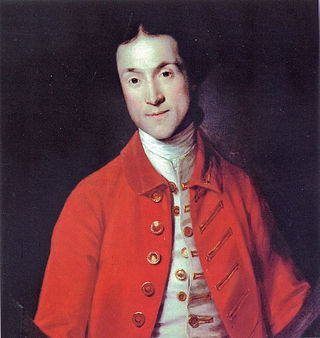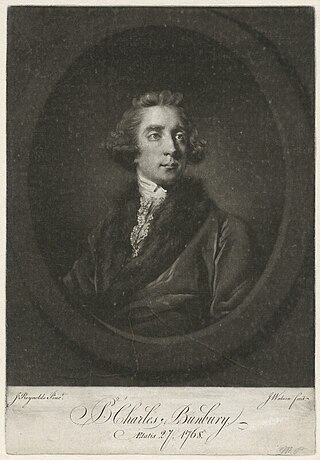Related Research Articles

Bahram (1932–1956) was an Irish-bred, English-trained Thoroughbred racehorse. He was undefeated in nine races in a career that lasted from July 1934 until September 1935. He was one of the most impressive horses and was named "Horse of the century" and The leading British two-year-old of 1934. He went on to take the Triple Crown in 1935 by winning the 2000 Guineas Stakes, Epsom Derby, and St. Leger Stakes. He was retired to stud at the end of the year. After a promising start to his stud career in Britain, he was exported to the United States, where he had moderate success before being exported again to Argentina.

Flying Childers (1715–1741) was a famous undefeated 18th-century thoroughbred racehorse, foaled in 1714 at Carr House, Warmsworth, Doncaster, and is sometimes considered as the first truly great racehorse in the history of thoroughbreds and the first to catch the public imagination.

Highflyer was an undefeated Thoroughbred racehorse and a very successful sire of the 18th century.

Bay Middleton was an undefeated Thoroughbred racehorse whose victories included two British Classic Races. He was twice the Leading sire in Great Britain and Ireland.
Selima was one of the most important Thoroughbred horses of the 18th century and became one of the foundation mares of the American Thoroughbred. She was imported to Maryland between 1750 and 1752 by Benjamin Tasker, Jr.

Eleanor was a British Thoroughbred racehorse bred by Charles Bunbury and was the first female horse to win The Derby. Eleanor also won the 1801 Epsom Oaks among many other races before retiring from racing at age eight to become a broodmare for Bunbury. She produced the stallion Muley, which in turn sired the mare Marpessa and the influential stallion Leviathan which was exported to the United States in the early nineteenth century. Through the produce of her daughter Active, Eleanor is present in the pedigrees of 19th-century American Standardbred racehorses.
Ditto (1800–1821) was a British Thoroughbred racehorse and sire. During a racing career that lasted from May 1803 to April 1807 he was lightly campaigned, running six times in five seasons and winning four races. In the summer of 1803 he proved himself one of the best British colts of his generation, by winning Derby on his only appearance on the season. He went on to win two important races at Newmarket and a King's Plate at Guildford. Ditto was retired to stud in 1808 and had some success as a sire of winners.
Aimwell was a British Thoroughbred racehorse. In a career that lasted from autumn 1784 to spring 1786, he ran eight times and won five races. In 1785, he won the sixth running of the Epsom Derby as well as three races at Newmarket. He was beaten in his only race in 1786, and did not appear in any subsequent records.

Snap was a Thoroughbred racehorse who won all four of his races. After retiring from racing he became a successful stallion. He was Champion sire four times and his progeny included the undefeated Goldfinder.
Catgut was a British Thoroughbred racehorse and broodmare who won the classic 1000 Guineas at Newmarket in 1819. The Guineas was the filly's only competitive win in six races, her other victory coming when she was allowed to walk over on her racecourse debut.

Bay Bolton or Brown Lusty (1705–1736) was a British Thoroughbred racehorse who won Queen Anne's Gold Cup as a five-year-old in 1710. After retiring from racing he became a successful sire for the Charles Paulet, 2nd Duke of Bolton, and his son Charles Powlett, 3rd Duke of Bolton, was Champion sire seven times.

Cobweb (1821–1848) was an undefeated British Thoroughbred racehorse and who won two British Classic Races as a three-year-old and went on to become a highly successful broodmare. Cobweb's racing career consisted of three competitive races in the early part of 1824. After winning on her debut she claimed a second prize when her opponents were withdrawn by their owners. She then won the 1000 Guineas at Newmarket Racecourse and the Oaks Stakes at Epsom Downs Racecourse before being retired to stud.

Nike was a British Thoroughbred racehorse. She won three of her five starts, including the Oaks Stakes in 1797. She was owned by Richard Grosvenor, 1st Earl Grosvenor, and later became a broodmare, with three of her foals placing in Classic races.

Penelope (1798–1824) was a British Thoroughbred racehorse. She won sixteen of her twenty-four races, including two Oatlands Stakes, the Jockey-Club Plate and she beat Oaks and Derby winner Eleanor. She was bred and owned by Augustus FitzRoy, 3rd Duke of Grafton. After retiring from racing she became an influential broodmare, foaling Derby winners Whalebone and Whisker and 1000 Guineas winner Whizgig.

Young Giantess (1790–1811) was a British Thoroughbred racehorse and broodmare. She failed to win any of the five races she contested, but became a successful broodmare for Sir Charles Bunbury. She foaled the successful sire Sorcerer and Derby and Oaks winner Eleanor.
Squirrel was a British Thoroughbred racehorse. He won seven of his nine races, including the 1400 Guineas Stakes and match races against Dapper and Jason. He was also a successful stallion, siring Craven Stakes winner Firetail. However he was more well known for producing broodmares, siring the dams of seven Classic winners including Derby winner Noble, along with the dam of champion sire Trumpator. Squirrel was owned by Jenison Shafto.
Squirt was a Thoroughbred racehorse, best known as the grandsire of Eclipse, founder of the breed's dominant sire line. He lived at a time when the Thoroughbred breed was in its infancy, before even the foundation of the Jockey Club and General Stud Book. Thus information is incomplete.

Toboggan was a British Thoroughbred racehorse and broodmare. She showed very promising form as a juvenile in 1928 when she won three of her four races including the Dewhurst Stakes. In the following year she finished third in the 1000 Guineas and went on to win the Epsom Oaks, Coronation Stakes and Jockey Club Stakes. She had some success as a broodmare producing the top-class winner Bobsleigh and Hydroplane, the dam of Citation.
Four Course was a British Thoroughbred racehorse. She was one of the best two-year-old fillies of her generation in England when she won three of her four races, namely the July Stakes, Richmond Stakes and Gimcrack Stakes. In the following spring she won the 1000 Guineas and finished second in both the Epsom Oaks and the Falmouth Stakes. She was retired at the end of the year but died before she could make and mark as a broodmare.

Pillion was a British Thoroughbred racehorse and broodmare. As a juvenile in 1925 she showed promising form by winning once and finishing second in three races including the Rous Memorial Stakes and the Cheveley Park Stakes. On her three-year-old debut she recorded a 25/1 upset victory in the 1000 Guineas. She was retired from racing at the end of the season and had some influence as a broodmare.
References
- 1 2 3 4 5 6 7 8 9 10 11 12 Pick, William; Johnson, R. (1803). The Turf Register. A. Bartholoman, High-Ousegate.
- ↑ "Thoroughbred Foundation Sires - B". www.tbheritage.com. Retrieved 2024-08-29.
- ↑ "Foundation Breeders: North Yorkshire and the Tees". www.tbheritage.com. Retrieved 2024-08-29.
- 1 2 3 4 5 6 The General Stud Book. J. S. Skinner, Baltimore. 1834. Retrieved 2012-12-30.
- ↑ "Gimcrack". Bloodlines.net. Retrieved 2012-12-30.
- ↑ "Thoroughbred Foundation Sires". Tbheritage.com. Retrieved 2012-12-30.
- ↑ "Thoroughbred Foundation Sires". Tbheritage.com. Retrieved 2012-12-30.